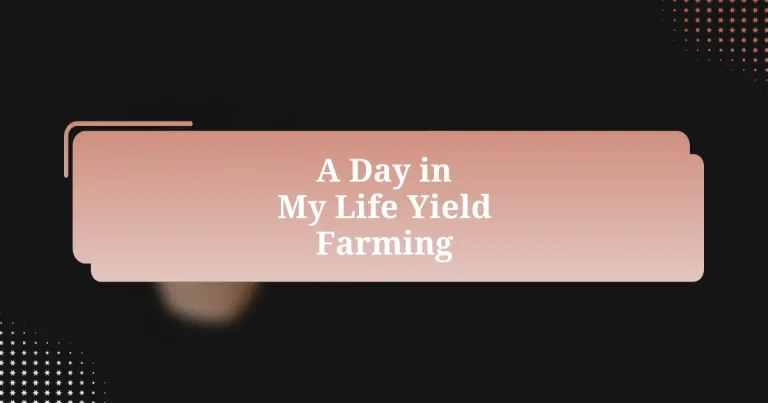Key takeaways:
- Yield farming enables individuals to earn rewards by lending or staking cryptocurrencies, akin to passive income in traditional finance.
- Decentralized Finance (DeFi) eliminates intermediaries, allowing peer-to-peer transactions and fostering financial independence.
- Yield farming offers high potential returns, liquidity benefits, and flexibility, enhancing users’ financial strategies.
- Utilizing tools like wallets and analytics platforms, alongside community engagement, is crucial for successful yield farming.
What is Yield Farming
Yield farming is a practice in decentralized finance (DeFi) where individuals lend or stake their cryptocurrencies in return for rewards, often in the form of additional tokens. I remember when I first heard about yield farming; the concept seemed a bit daunting, yet there was an intriguing simplicity to it. Could it really be as straightforward as putting my crypto to work and watching it grow?
At its core, yield farming allows me to maximize my crypto holdings by taking advantage of various DeFi protocols that offer attractive interest rates. The experience feels almost like earning passive income through traditional banking, but with a sense of excitement and risk that I often find addictive. I often ask myself, how can money work for me in ways that traditional finance might not allow? Yield farming shows me the potential of earning while I sleep, but it also requires a good understanding of the risks involved, as the DeFi landscape can be quite volatile.
The allure of yield farming lies in its potential for high returns, but I’ve learned the importance of doing thorough research before diving in. I distinctly recall a moment of uncertainty when I first staked my tokens; it was both exhilarating and nerve-wracking. This duality of excitement and caution encapsulates what yield farming is truly about, blending opportunity with the ever-present need for vigilance in a fast-moving space.
Understanding Decentralized Finance
Decentralized Finance, or DeFi, is transforming the way I interact with money. Unlike traditional finance, DeFi operates without intermediaries like banks, relying on blockchain technology to facilitate peer-to-peer transactions. I still recall the moment it clicked for me: the realization that I could lend my assets directly to others and earn returns without anyone skimming a percentage off the top. Isn’t it liberating to think that this kind of financial independence is within reach?
As I immersed myself in DeFi, I was struck by its community-driven nature. Everyone has a stake and a voice in the ecosystem, whether through governance tokens or shared initiatives. I often wonder: how would this shift in power dynamics affect our financial future? The fact that users can participate in decision-making processes truly adds a layer of connection and responsibility that I find invigorating. It feels more like a movement than just a series of transactions.
While exploring DeFi has been exciting, I’ve also encountered a maze of protocols and platforms that can leave newcomers feeling overwhelmed. I vividly remember grappling with different platforms and wondering which ones to trust. Each platform presents unique opportunities and risks, creating a landscape that requires constant learning and adaptation. For me, it’s about striking a balance—how can I capitalize on these innovative tools while navigating the potential pitfalls? Engaging with DeFi means embracing both the excitement and uncertainty that comes with this rapidly evolving financial frontier.
Benefits of Yield Farming
Yield farming offers substantial benefits that can really enhance my financial journey. One of the most enticing aspects is the potential for high returns. I remember the first time I staked my assets; seeing my initial investment multiply over time felt almost magical. It’s fascinating how platforms incentivize users with lucrative rewards, often much higher than traditional banking interest rates.
In addition to impressive returns, yield farming promotes liquidity within networks. As I engage with various DeFi projects, I’ve observed how providing liquidity improves the overall health of the ecosystem. It’s like being part of a thriving community where my contributions directly impact the operation and efficiency of that system. Every transaction feels significant, as if I’m playing a role in something greater than just my financial gain.
Another benefit that I cherish is the flexibility yield farming provides. Unlike traditional investment vehicles, I have the freedom to move my assets across different platforms and protocols. I often ask myself, “How would my financial strategy shift if I could adjust my investments in real-time?” This adaptability has allowed me to maximize gains while minimizing risks, illustrating that in yield farming, agility can be just as important as strategy.
Tools for Yield Farming
When diving into yield farming, I’ve found that the right tools can make a significant difference. A good wallet, like MetaMask, is essential for securely managing my cryptocurrencies, while lending protocols such as Aave or Compound offer robust platforms to lend my assets and earn interest. I remember my first experience with these tools; the ease of connecting my wallet and exploring different yields felt empowering.
Analyzing data is crucial in yield farming, and platforms like DeFi Pulse or Dune Analytics have become invaluable to me. They offer insights into various projects, helping me make educated decisions about where to allocate my assets. Sometimes, I wonder, “How do others track their investments?” For me, the ability to visualize performance and trends in real-time adds a layer of confidence to my choices.
Moreover, joining communities on platforms like Discord or Telegram allows me to stay updated and exchange tips with fellow farmers. I can’t stress enough how these interactions enhance my understanding and strategies. It’s like being in a vibrant marketplace, where sharing knowledge not only motivates me but also strengthens my connection to the entire yield farming experience. How often do we find ourselves learning and growing within a community? For me, it makes all the difference.

